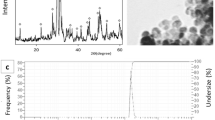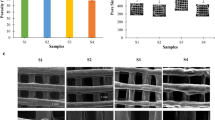Abstract
The formation of nacreous layers of abalone shell (Aba) is a similar process to the deposition of calcium salts in human bone, with the main mechanism being the orderly mineralization of inorganic matter mediated by organic bioactive components. In this study, 3D printing technology was employed to use the abundant calcium sources and bioactive substances in Aba to enhance the osteoinductive and remineralization capacity of materials in implants for bone regeneration. The novel hybrid scaffolds were successfully 3D-printed from polycaprolactone (PCL), which has good toughness and processability, doped with powdered Aba. When the Aba particle do** was increased from 0 to 15%, the physicochemical properties of PCL were virtually unchanged, while the surfaces of scaffolds became rough, and Aba particles were gradually exposed. The Aba/PCL scaffolds had an interconnected pore structure with a pore size of approximately 200 μm and over 50% porosity, which was convenient for the transport of nutrients. With the addition of Aba, the thermodynamic stability and mechanical properties of the scaffolds significantly improved, and the maximum compressive strength and modulus reached 1.34 and 1.89 MPa, respectively, because Aba provided nucleation sites for nanohydroxyapatite (nHAP) to promote mineralization. In vitro cell experiments showed that the hybrid scaffolds had good biocompatibility and promote the proliferation of osteoblasts. In vivo results revealed that the hydroxyapatite of organic matter and trace elements in Aba particles induced the migration of stem cells and active factors to the site of a bone defect. The implantation of 3D-printed scaffolds offered a microenvironment for osteoblast attachment and proliferation, which further promotes osteogenesis-related gene expression, such as bone gamma carboxyglutamate protein (BGLAP), type I collagen (COL1A1), and secreted phosphoprotein 1 (SPP1), and facilitated the repair of a skull defect. This high-value applications of Aba have the potential to improve environmental pollution and provide potentially low-cost, high-performance bone repair materials for clinical use.







Similar content being viewed by others
References
Hou Y, Shavandi A, Carne A, Bekhit AA, Ng TB, Cheung RCF, Bekhit AE-dA (2016) Marine shells: potential opportunities for extraction of functional and health-promoting materials. Crit Rev Env Sci Tec 46:1047–1116
Mokhtari S, Eftekhari Yekta B, Marghussian V, Ahmadi PT (2020) Synthesis and characterization of biodegradable AZ31/calcium phosphate glass composites for orthopedic applications. Adv Compos Hybrid Ma 3(3):390–401
Pei J, Wang Y, Zou X, Ruan H, Tang C, Liao J, Si G, Sun P (2021) Extraction, purification, bioactivities and application of matrix proteins from pearl powder and nacre powder: a review. Front Bioeng Biotechnol 9:649665
Long J, Zhang W, Chen Y, Teng B, Liu B, Li H, Yao Z, Wang D, Li L, Yu X-F, Qin L, Lai Y (2021) Multifunctional magnesium incorporated scaffolds by 3D-Printing for comprehensive postsurgical management of osteosarcoma. Biomaterials 275:120950
Lin H, Shi S, Lan X, Quan X, Xu Q, Yao G, Liu J, Shuai X, Wang C, Li X, Yu M (2021) Scaffold 3D-printed from metallic nanoparticles-containing ink simultaneously eradicates tumor and repairs tumor-associated bone defects. Small Methods 5:e2100536
Yang C, Ma H, Wang Z, Younis MR, Liu C, Wu C, Luo Y, Huang P (2021) 3D printed wesselsite nanosheets functionalized scaffold facilitates NIR-II photothermal therapy and vascularized bone regeneration. Adv Sci 8:e2100894
Pan P, Yue Q, Li J, Gao M, Yang X, Ren Y, Cheng X, Cui P, Deng Y (2021) Smart cargo delivery system based on mesoporous nanoparticles for bone disease diagnosis and treatment. Adv Sci 8:e2004586
Espinosa HD, Rim JE, Barthelat F, Buehler MJ (2009) Merger of structure and material in nacre and bone–perspectives on de novo biomimetic materials. Prog Mater Sci 54:1059–1100
Macha IJ, Ben-Nissan B (2018) Marine skeletons: towards hard tissue repair and regeneration. Mar Drugs 16:225
**ng H, Yang F, Sun S, Pan P, Wang H, Wang Y, Chen J (2022) Green efficient ultrasonic-assisted extraction of abalone nacre water-soluble organic matrix for bioinspired enamel remineralization. Colloids Surf B 212:112336
Ma J, Li ZJ, Xue YZB, Liang XY, Tan ZJ, Tang B (2020) Novel PEEK/nHA composites fabricated by hot-pressing of 3D braided PEEK matrix. Adv Compos Hybrid Ma 3(2):156–166
Mount AS, Wheeler AP, Paradkar RP, Snider D (2004) Hemocyte-mediated shell mineralization in the eastern oyster. Science 304:297–300
Zhang G, Brion A, Willemin AS, Piet MH, Moby V, Bianchi A, Mainard D, Galois L, Gillet P, Rousseau M (2017) Nacre, a natural, multi-use, and timely biomaterial for bone graft substitution. J Biomed Mater Res A 105:662–671
Carson MA, Clarke SA (2018) Bioactive compounds from marine organisms: potential for bone growth and healing. Mar Drugs 16:304
Barthelat F, Yin Z, Buehler MJ (2016) Structure and mechanics of interfaces in biological materials. Nat Rev Mater 1:16007
Hu Y, Cao S, Chen J, Zhao Y, He F, Li Q, Zou L, Shi C (2020) Biomimetic fabrication of icariin loaded nano hydroxyapatite reinforced bioactive porous scaffolds for bone regeneration. Chem Eng J 394:124895
Zhao Y, Chen J, Zou L, Xu G, Geng Y (2019) Facile one-step bioinspired mineralization by chitosan functionalized with graphene oxide to activate bone endogenous regeneration. Chem Eng J 378:122174
Yang Y, Yao Q, Pu X, Hou Z, Zhang Q (2011) Biphasic calcium phosphate macroporous scaffolds derived from oyster shells for bone tissue engineering. Chem Eng J 173:837–845
Du M, Li Q, Chen J, Liu K, Song C (2021) Design and characterization of injectable abalone shell/calcium sulfate bone cement scaffold for bone defect repair. Chem Eng J 420:129866
Kakisawa H, Sumitomo T (2011) The toughening mechanism of nacre and structural materials inspired by nacre. Sci Technol Adv Mater 12:064710
Kim H, Lee K, Ko CY, Kim HS, Shin HI, Kim T, Lee SH, Jeong D (2012) The role of nacreous factors in preventing osteoporotic bone loss through both osteoblast activation and osteoclast inactivation. Biomaterials 33:7489–7496
Dimas LS, Bratzel GH, Eylon I, Buehler MJ (2013) Tough composites inspired by mineralized natural materials: computation, 3D printing, and testing. Adv Funct Mater 23:4629–4638
Li L, Lu H, Zhao Y, Luo J, Yang L, Liu W, He Q (2019) Functionalized cell-free scaffolds for bone defect repair inspired by self healing of bone fractures: a review and new perspectives. Mater Sci Eng C 98:1241–1251
Vaquette C, Bock N, Tran PA (2020) Layered antimicrobial selenium nanoparticle-calcium phosphate coating on 3d printed scaffolds enhanced bone formation in critical size defects. ACS Appl Mater Interfaces 12:55638–55648
Wang Q, Ma Z, Wang Y, Zhong L, **e W (2020) Fabrication and characterization of 3D printed biocomposite scaffolds based on PCL and zirconia nanoparticles. Bio Des Manuf 4:60–71
Yan Y, Chen H, Zhang H, Guo C, Yang K, Chen K, Cheng R, Qian N, Sandler N, Zhang YS, Shen H, Qi J, Cui W, Deng L (2019) Vascularized 3D printed scaffolds for promoting bone regeneration. Biomaterials 190:97–110
Bartnikowski M, Dargaville TR, Ivanovski S, Hutmacher DW (2019) Degradation mechanisms of polycaprolactone in the context of chemistry, geometry and environment. Prog Poly Sci 96:1–20
Yang T, Hu Y, Wang C, Binks BP (2017) Fabrication of hierarchical macroporous biocompatible scaffolds by combining pickering high internal phase emulsion templates with three-dimensional printing. ACS Appl Mater Interfaces 9:22950–22958
Ahn J-H, Kim J, Han G, Kim D, Cheon K-H, Lee H, Kim H-E, Kim Y-J, Jang T-S, Jung H-D (2021) 3D-printed biodegradable composite scaffolds with significantly enhanced mechanical properties via the combination of binder jetting and capillary rise infiltration process. Addit Manuf 41:101988
Kuang T, Chen S, Gu Z, Shen Z, Hejna A, Saeb MR, Chen F, Zhong M, Liu T (2022) A facile approach to fabricate load-bearing porous polymer scaffolds for bone tissue engineering. Adv Compos Hybrid Ma 3(4):170–181
Kim D, Lee J, Min Seok J, Jung J-Y, Hee Lee J, Sik Lee J, Lee K, Park SA (2021) Three-dimensional bioprinting of bioactive scaffolds with thermally embedded abalone shell particles for bone tissue engineering. Mater Des 212:110228
Zou L, Hu L, Pan P, Tarafder S, Du M, Geng Y, Xu G, Chen L, Chen J, Lee CH (2022) Icariin-releasing 3D printed scaffold for bone regeneration. Compos B Eng 232:109625
Dadhich P, Srivas PK, Das B, Pal P, Dutta J, Maity P, Guha Ray P, Roy S, Das SK, Dhara S (2021) Direct 3D printing of seashell precursor toward engineering a multiphasic calcium phosphate bone graft. ACS Biomater Sci Eng 7:3806–3820
Liu D, Nie W, Li D, Wang W, Zheng L, Zhang J, Zhang J, Peng C, Mo X, He C (2019) 3D printed PCL/SrHA scaffold for enhanced bone regeneration. Chem Eng J 362:269–279
Ahmed MK, Zayed MA, El-Dek SI, Hady MA, El Sherbiny DH, Uskokovic V (2021) Nanofibrous epsilon-polycaprolactone scaffolds containing Ag-doped magnetite nanoparticles: physicochemical characterization and biological testing for wound dressing applications in vitro and in vivo. Bioact Mater 6(7):2070–2088
Wang H, Yan K, **ng H, Chen J, Lu R (2021) Effective removal of Cu2+ from aqueous solution by synthetic abalone shell hydroxyapatite microspheres adsorbent. Environ Technol Inno 23:101663
Lai Y, Cao H, Wang X, Chen S, Zhang M, Wang N, Yao Z, Dai Y, **e X, Zhang P, Yao X, Qin L (2018) Porous composite scaffold incorporating osteogenic phytomolecule icariin for promoting skeletal regeneration in challenging osteonecrotic bone in rabbits. Biomaterials 153:1–13
Peng C, Zheng J, Chen D, Zhang X, Deng L, Chen Z, Wu L (2018) Response of hPDLSCs on 3D printed PCL/PLGA composite scaffolds in vitro. Mol Med Rep 18:1335–1344
Funding
This work was supported by Natural Science Foundation of Shandong Province (no. ZR2022QD057), the Open Project Fund for Hubei Key Laboratory of Oral and Maxillofacial Development and Regeneration (No. 2021kqhm003), the State Key Laboratory of Advanced Technology for Materials Synthesis and Processing (Wuhan University of Technology), the Physical Chemical Materials Analytical and Testing Center of Shandong University at Weihai, China Postdoctoral Science Foundation (2022M722434) and the Science Fund of Shandong Laboratory of Advanced Materials and Green Manufacturing (Yantai, No. AMGM2021F02).
Author information
Authors and Affiliations
Contributions
P.P. wrote the main manuscript text. Y.G. and L.H. conceived and designed research. Q.L., M.L., L.C., and M.C. conducted experiments. J.C. contributed new reagents or analytical tools. All authors reviewed the manuscript.
Corresponding author
Ethics declarations
Conflict of interest
The authors declare no competing interests.
Additional information
Publisher's Note
Springer Nature remains neutral with regard to jurisdictional claims in published maps and institutional affiliations.
Supplementary Information
Below is the link to the electronic supplementary material.
Rights and permissions
Springer Nature or its licensor (e.g. a society or other partner) holds exclusive rights to this article under a publishing agreement with the author(s) or other rightsholder(s); author self-archiving of the accepted manuscript version of this article is solely governed by the terms of such publishing agreement and applicable law.
About this article
Cite this article
Pan, P., Geng, Y., Hu, L. et al. Biologically enhanced 3D printed micro-nano hybrid scaffolds doped with abalone shell for bone regeneration. Adv Compos Hybrid Mater 6, 10 (2023). https://doi.org/10.1007/s42114-022-00593-1
Received:
Revised:
Accepted:
Published:
DOI: https://doi.org/10.1007/s42114-022-00593-1




